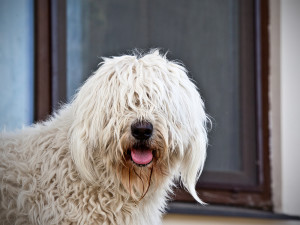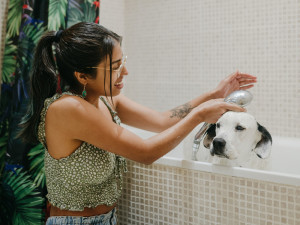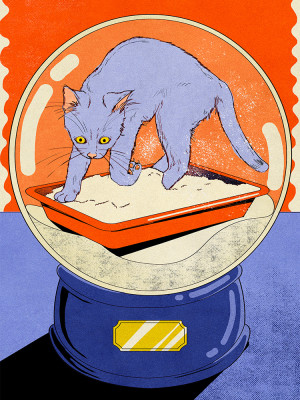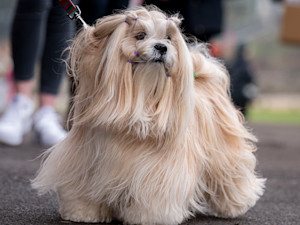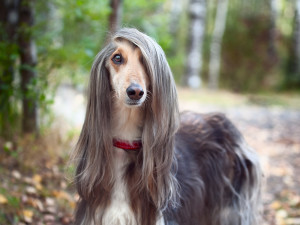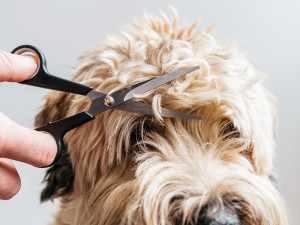Enough With The Shedding! How To Stop Your Dog From Getting Hair Everywhere
Vets, groomers and cleaning experts weigh in on how to manage when you’re drowning in dog fur
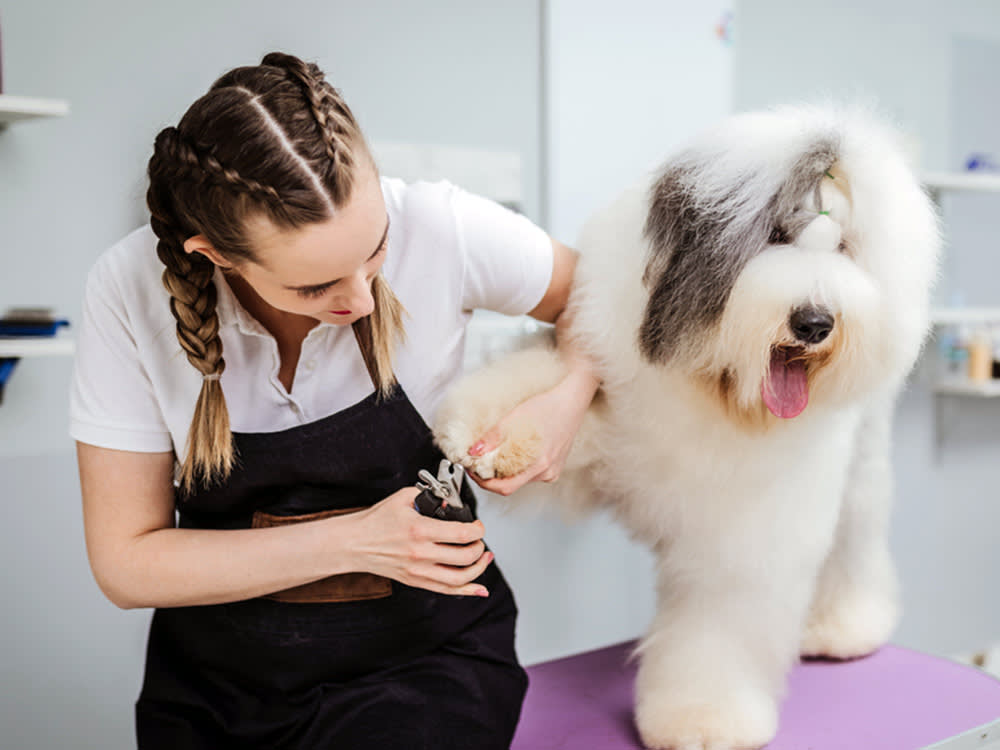
share article
Imagine this combination: wooden floors, a cream dog, dog hair and a clean freak (me). I end up on all fours, crawling all over the room to pick up all the balls of hair my dog has left behind. Sounds familiar? Sometimes even vacuuming won’t cut it! And my dog is small, so I can’t imagine how much larger dogs shed.
Dog owners will know that shedding can be pretty annoying. I’m sure you’ve seen the videos saying that dog hair is like the love the dog has for you: it’s a lot and it’s everywhere. While it’s natural for a dog to shed, I am always on the lookout for ways to reduce it.
I’m sure I’m not alone in this and although shedding comes with the territory, it sticks everywhere, from furniture to clothes, and often it won’t come off in the wash. The Wildest spoke to the experts to understand how shedding can be reduced and when excessive shedding warrants a trip to the vet.
Why do dogs shed?
Shedding is natural for dogs and essential for their skin and fur health. The damaged hair sheds away so that new, healthy fur can grow. Like all mammals, dogs have a regular hair cycle, where shedding is essential.
“Just like humans, hair follicles die off and with them falls out the hair,” notes veterinary surgeon Dr Scott Milleropens in a new tab.
“The shedding is influenced by many factors including breed, age, time of year and your dog’s hormonal cycle. Each hair has its life cycle, and as new hair grows, old hair gets dropped” says Dr Sean McCormack, head vet at Tails.comopens in a new tab.
Which dog breeds shed the most?
Certain breeds are known to shed more, these include Huskies, Akitas, Alaskan Malamutes, Pyrenean Mountain Dogs, Corgis, Chow Chows as well as Labrador Retrievers and German Shepherds. This is due to their thicker coats and need to regulate their temperature all year round.
Which dog breeds don’t shed?
You may have heard of ‘hypoallergenic’ dogsopens in a new tab, which is a bit of a myth, Dr McCormack says. People with dog allergies have issues with the shed skin and dander not with the hair itself. So, no dog is truly OK if someone is allergicopens in a new tab, but some dogs shed less than others.
Even the breeds that are known as non- or low-shedding do, in fact, shed, just more slowly so it might be less noticeable, explains Dr Anna Foreman, in-house vet at Everypaw Pet Insuranceopens in a new tab.
The breeds that shed less include Poodles (which explains why they have become the ‘it’ breed of the moment), Miniature Schnauzers and Yorkshire Terriers, says Dr Foreman.
Breeds like the Bichon Frisé and Maltese are also low shedding as they have a coat type that’s more like human hair than dog fur, explains Dr McCormack.
“Poodles don’t shed as much, one of the reasons why the ‘oodle’ cross breed craze came about as owners looked for their favourite breeds in a form that did not shed,” says Dr Miller.
To note, even dogs that don’t shed (as much) need regular grooming, says Dr Foreman. This is in order to stop painful matting.
Do female dogs shed more?
“Generally their shedding patterns are similar, sex doesn’t make much of a difference to timing or amount of shedding,” says Dr McCormack.
However female dogs will tend to shed more due to hormonal changes, like going into a heat cycle or during pregnancy.
Is there such a thing as ‘shedding season’?
Somewhat. Most breeds will shed more in the spring and autumn seasons, characterised as a ‘moulting season’, as the temperature changes, especially those with a double-coat like Huskies, say Dr Foreman and Dr Miller.
“This helps dogs adapt to changing temperatures, losing their thicker winter coat as the days lengthen and weather warms up. And regaining it again as winter approaches,” explains Dr McCormack.
However, he notes that this cycle is typical for working dogs kept mostly outdoors, whereas “our pampered pooches living the life of luxury inside with central heating in winter may not exhibit noticeable seasonality of shedding patterns at all”.
When should I be worried about my dog shedding?
Dogs can shed more if they are unwell, if they are stressedopens in a new tab or if they have certain health conditions.
According to Dr Jeremy Carr from MediVetopens in a new tab, pet parents should speak to a vet when their dog is shedding a lot more than normal, or if there is little to no hair covering the skin in certain areas and they have developed bald patches.
Plus, inflammation and itchy or irritated skinopens in a new tab should also be checked out by a doctor, says Dr McCormack, to rule out any medical conditions.
What can excessive shedding signify?
Excessive shedding can be caused by various things says Dr McCormack, like “allergies, hormonal imbalances, parasitic infestations, bacterial or yeast infections, hormonal disorders, thyroid problems, or skin infections”.
Excessive shedding and hair loss can lead to alopecia, Dr Carr says and can be caused by certain metabolic diseases like low thyroid or other skin diseases including mites.
Dr Miller says that Cushing’s disease can lead to a thinning coat, and parasites can cause itching which then leads to loss of hair.
Can you stop a dog from shedding and is it safe?
You can’t (and shouldn’t) stop your dog from shedding, as that would disrupt their natural process and nothing will stop an animal from shedding altogether, says Dr Foreman. However, there are some things you can do to reduce it.
The first is regular grooming like brushing and bathing, which will help remove the excess hair before it ends up all over your floor or clothes.
“Improving the skin and coat condition with the use of products or ingredients containing essential fatty acidsopens in a new tab can reduce shedding,” says Dr Miller.
“Adding supplements like fish oil to your dog’s diet can potentially reduce shedding, as they are rich in Omega-3 fatty acidsopens in a new tab, which have many health benefits, especially in boosting the protective function of the skin barrier and improving coat health,” agrees McCormack.
Dr McCormack explains using excessive force or harsh grooming toolsopens in a new tab when brushing your dog is a big no-no. “Never shave a double-coated breed to try to reduce shedding, as this can affect their natural insulation and lead to skin problems or prolonged shedding,” he adds.
The best way to clean up dog hair
Sabrina Tretyakovaopens in a new tab, an ISSA-certified cleaning expert, who uses eco-friendly, industry-leading Fortador technology for her clients, recommends various cleaning methods depending on the surface you are looking to clean.
For clothes, she says to wear rubber gloves or dampen your hands, and run your hands over the clothes to clump the hair together. “Hair sticks to rubber or damp surfaces, making removing them from the cloth fibres easy,” she says. Then you can mix some fabric softener with water in a spray bottle, to spray on the clothes before wiping them with a paper towel, which helps remove residual hair, explains Sabrina.
For other surfaces, like furniture and cars, a lint roller or sticky lint brush is your first defence, but a reusable fabric roller may work even better. Plus, a special pet vacuum can be used to pick up hair, these may differ from your regular vacuum, as they have been created to withstand cleaning large amounts of pet hair, and the motor won’t die on you.
Any fabrics that are fur-covered can be put in a clothes dryer on a low-heat cycle, with a wet microfibre cloth. “The hair sticks to the microfibre, making it easier to remove,” says Sabrina.
I’ve personally found great success with a little tool I found on TikTok called Fur Vikingopens in a new tab and works particularly well on our sofa.
And because people on TikTok are doing it... is it safe to vacuum your shedding dog?
Dr Carr says that vacuuming a dog’s hair has become rather popular and if you were to try this, make sure to use a specific dog hair attachment and low suction.
Both Dr Foreman and Dr McCormack agree that this can be a scary experience for your dog, especially if they don’t like loud noises. If forced, the dogs may become aggressive, Dr Foreman notes.
If you were to try it, do so slowly, with positive reinforcement, praise and treats.
For dogs that tolerate loud noises, a pet-specific brush attachment like the Dyson Pet Grooming Kit, can be effective at removing loose fur while minimising stress for your pup, says Dr McCormack.
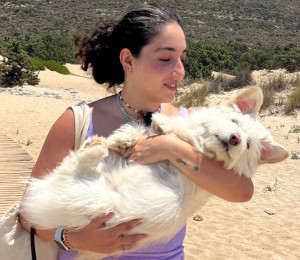
Fani Mari
Fani is a freelance journalist, copywriter and content creator from Greece and a former Londoner. She has written for various publications including Condé Nast Traveller, Allure, Glamour and Refinery29. When she’s not quizzing dermatologists on the next it-ingredient or filming makeup videos, you can find her binge-watching shows, making candles and taking long walks in nature. She lives in Athens, Greece with her boyfriend and their dog, Joey, who obviously doesn’t share food.
Related articles
![Long haired blonde lhasa apso dog at crufts 2024]() opens in a new tab
opens in a new tabTop Grooming Tips From The Crufts Pros
We can only dream of having hair as good as these pups
![A afghan hound standing in the woods with long silky hair.]() opens in a new tab
opens in a new tabA Beauty Editor’s Favourite Shampoos – For Dogs
And yes, gen Z dogs can still rock side parts
![A person giving a dog a bath in a bathtub.]() opens in a new tab
opens in a new tabTips On How to Brush and Bathe Your Dog From a Pro
Groomer Robyn Michaels explains how to keep your pup well-groomed
![A wheaten terrier getting a haircut to remove the hair from over his eyes]() opens in a new tab
opens in a new tab9 of the Best Dog Grooming Products
Tools to keep your pet looking so fresh and so clean, from bamboo hair brushes to biodegradable wipes
![greyhound dog being washed in tub]() opens in a new tab
opens in a new tabLather, Rinse, Repeat: the Ultimate Dog Grooming Guide
Keep your dog well-groomed but trust trims to the pros
![an illustration of a cat inside a snowglobe]() opens in a new tab
opens in a new tabWhat Happens When the Love of Your Life Is Allergic to the Other Love of Your Life?
You don’t have to choose between your SO and your dog or cat – but here’s what may need to happen
